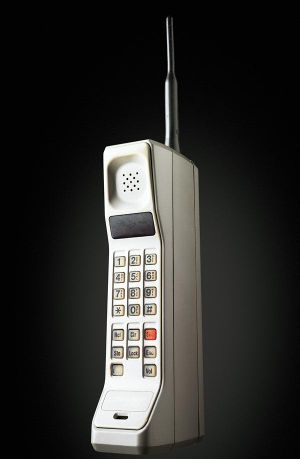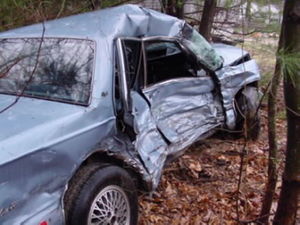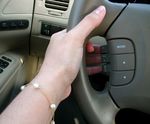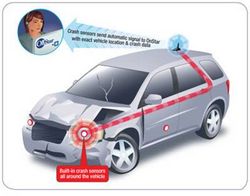Group 1: Cheng, Dalton, Devin, Lauren, Stephen
Contents
Implications of Technology on Safety While Driving
Introduction
External technological devices have become an integral part of everyday life. Almost everyone has a cell phone and it is rare to find someone who drives without listening to music or the radio. There have been many conflicting opinions as to whether or not to ban any of these distractions in vehicles. This page will examine the different external technologies, existing laws, and offer suggestions for safer driving conditions.
Statistical and Legal Relevance of the Detrimental Effects of Cell Phone use While Driving
Traffic collisions kill 6 people, and injure 500 people weekly in Alberta alone. It has been ascertained that driver distraction is responsible for between 25% and 30% of these collisions. When questioned about cell phone use while driving, 68% of people admitted to use. It has been proven that people who use a cell phone (either hand-held or hands-free) while driving are 4 times as likely to have a traffic collision.
Cell phone use while driving increases the risk of collision for the following reasons:
1. Cell phone use while driving slows the driver’s reaction time by 13%.
2. It increases the risk of rear-end collisions by 200%.
3. It reduces visual field attention.
4. Increases the probability of running a red light.
5. It has been proven to lead to greater detriment in driving performance than the maximum blood alcohol limit (30 mg/100ml).
6. When conversing with a passenger it is different because the passenger can adapt the conversation to suit the driving conditions.
Employers are being held accountable/liable for collisions involving employees that were using a cell-phone while driving. In 2001, in Miami, a woman was awarded $20.9 million after being injured in a car crash caused by a salesman who was using a cell phone between appointments.
The World is on Board: Australia, Hong Kong, Hungary, and Russia are a few of the countries that are involved in the banning of cell phone use. Globally, there are many more countries with partial bans in place with a differentiation between using a hands free and hand-held cell phone. These countries have banned hand-held cell phones outright, and are currently researching the effects of using hands free to determine whether it should follow suit. New Delhi, in India, has banned cell phone use entirely including the use of a hands-free unit as of July 2001. India has gone even further in its attempts to deter this activity by enforcing with prison sentences. In Canada: Only 3 provinces are on board at the moment, these include Newfoundland, Quebec and Ontario. Cell phone use was banned In Newfoundland in December of 2002, with fines of up to $180. Quebec banned use of cell phones in April of 2008, instituting fines of up to $100.
A major cause of motor vehicle collisions is driver inattentiveness. A 2003 study out of the University of Utah looked explicitly at the affects of hands-free devices on driving to assess the affect of using such a device on driving performance.
“This research examined the effects of hands-free cell phone conversations on simulated driving. The authors found that these conversations impaired driver’s reactions to vehicles braking in front of them. The authors assessed whether this impairment could be attributed to a withdrawal of attention from the visual scene, yielding a form of inattention blindness. Cell phone conversations impaired explicit recognition memory for roadside billboards. Eye-tracking data indicated that this was due to reduced attention to foveal information. This interpretation was bolstered by data showing that cell phone conversations impaired implicit perceptual memory for items presented at fixation. The data suggest that the impairment of driving performance produced by cell phone conversations is mediated, at least in part, by reduced attention to visual inputs.”
Cell Phone-Induced Failures of Visual Attention During Simulated Driving By David L. Strayer, Frank A. Drews, and William A. Johnston
"Another study from the University of Utah compared drivers using cell phones and drunk drivers, and came to the conclusion that “When controlling for driving difficulty and time on task, cell-phone drivers exhibited greater impairment than intoxicated drivers.” This statement is based on the idea that if a person was to drive for 20 minutes he would have a lower risk of incident than a person who completed the same 20 minute drive while talking on a cell phone the entire time."
Fatal Distraction? A Comparison of the Cell-Phone Driver and the Drunk Driver By David L. Strayer, Frank A. Drews, and Dennis J. Crouch
Technologies that Distract Drivers
Cell Phone
Technology of a Cell Phone
Cell phones, also called mobile phone, cellular phones or wireless phone are a combination of a radio and telephone, enabling the wireless functionality of a phone. Cell phones, however, are not restricted by distance as handheld radios are, enabling long distance data and voice communication to pretty much anywhere in the world. Cell phones communicate via cell sites run by individual cell phone carriers. Cell sites are usually towers with mounted antennas and electronic communications equipment are placed that create a hexagonal grid across cities, the countryside, and wherever cell phone coverage is found that enable radio frequencies to travel between the handset and the tower. The cell sites communicate with each other directing the data or voice communication to another cell phone, a landline, computer or other destination.
Functions of a cell phone
Cellular phones have become a multi-functional device capable of a variety of different applications such as:
- Voice calls
- Internet
- Sending/receiving emails
- SMS messaging (text messaging)
- MMS messaging (Multimedia messaging)
- Games
- Calendar
- Television
- Contacts
- GPS
- Office Mobile
- MP3 music and video
Radio
Radio is considered as one of the distraction devices that lead to car accidents and crashes. Changing CD while driving, looking for favorite programs, and making music too loud to focus on driving are the main causes of the accidents.
When drivers do not have both hands on the wheel and are looking away from the road, it increases their chances of getting into an accident. Below are accidents resulting from adjusting the radio while driving.
Technologies That Lessen the Distractions While Driving
New Technologies
New technologies have evolved in order to meet changing customer demands. Now, some vehicles come equipped with steering wheels that have audio controls built into them. The controls can either be on the front of the steering wheel or they can be on the back, allowing drivers to reach around and change the volume with their fingers. This way, the driver can keep their hand near or actually on the steering wheel.
OnStar
OnStar is a recent technological advancement which puts the phrase of “hands free” to a whole new level. Although it is only exclusive to the GM brand (which includes Buick, Cadillac, Chevrolet, GMC, HUMMER, Pontiac, SAAB, and Saturn) it allows for a whole new car experience in safety, theft protection, and navigation, all with the touch of a button.
Safety is by far one of the most important aspects to a vehicle, from the brake application, to air bag deployment, but what happens if you cannot respond because you are incapacitated. With OnStar there are built-in sensors all around your vehicle (including air bag deployment) that will notify an OnStar Emergency Advisor in the case of an accident. The Emergency Advisor then tries to see if you are okay, if there is no response they immediately let emergency services know about the crash and your location using GPS. OnStar also has a vehicle diagnostics which will allow them to tell emergency services about the type of crash and its severity. There is also a red emergency button that will connect you to an Emergency Advisor, twenty-four-seven.
Vehicle Diagnostics is available also with OnStar. This will send a monthly diagnostics report straight to you via email. It will let you know if you vehicle is in need of maintenance and the appropriate course of action needed to be taken. It checks your engine/transmission, emission, air bag, anti-lock brakes, and OnStar systems. By figuring out your mileage it can estimate your vehicles remaining oil life and when its time for regular maintenance work (like tire rotations). It can even tell you if your tire pressure is low! There is in addition a GM Goodwrench on Demand Diagnostics check as well, which allows the driver to check the status of their car on the spot, whether it’s being driven or parked. It connects you to an OnStar correspondent where they do a quick diagnostics check and let you know what the problem is, all with a push of a button.
Cell phones and driving is becoming an increasing problem with today’s society. OnStar offers a hands free calling system with the push of a button, so you can keep your hands on the wheel and eyes on the road. It is voice recognition, so you can dial numbers or call stored numbers using simple voice commands like dial or call. The radio will mute, and a ring tone will sound if you have an incoming call, and you can forward your calls to your hand held if needed. Calls can be connected even in limited cell phone reception areas and are rarely dropped. And with a surround-sound stereo system to listen to your conversation through, your calls will never sound better.
Don’t know where you’re going, don’t fumble around with a map, OnStar offers a GPS Navigation System. Tell your Advisor your desired destination and get a voice-guide telling the directions. With your Driver Information Center, you can see up coming turns and street names. The directions are always direct and fast, saving you fuel and time.
If your vehicle has been stolen, OnStar can work with the police and give them your car’s real time location using GPS. Also if you are in need of roadside assistance, they can give a service provider your exact location, again using GPS. This keeps you safe off of busy roads and lets you know help is on the way.
2006 Yearly OnStar Statistics
- Remote Unlocks: 552000
- Air Bag Notifications: 14400
- Stolen Vehicle Pinpoints: 6000
- Emergency Responses: 120000
- Good Samaritan Calls: 60000
- Roadside Assistance Help: 324000
- Vehicle Diagnostics Check: 360000
Bluetooth
What is Bluetooth?
Bluetooth is a technology that transfers data on low-power radio waves. These radio waves transmit at a frequency of 2.45 gigahertz (GHz). This frequency band has been specifically set aside for Bluetooth use by the international agreement for the use of industrial, scientific, and medical services (ISM). Bluetooth allows computers, entertainment systems, phones, printers, GPS receivers, and other various electrical devices to communicate with each other wirelessly. Bluetooth technology accomplishes this by creating wireless personal area networks (PANs). Bluetooth PANs are called piconets, and have a wireless range of 10 meters and can connect up to 8 devices.
Bluetooth Applications
Bluetooth is used for many different applications including:
- Wireless communication between phone, and wireless handsets
- Wireless networking between PC’s in small spaces, where little bandwidth is needed
- Wirelss communication with PC input and output devices such as: mouse keyboard and printer
- Transfer of files, contact details, calendar appointments and reminders
- Replacement of wired serial communications in test equipment, GPS receivers, medical equipment, bar code scanners and traffic control devices.
- Replace infrared technology in some devices
- Wireless controllers for gaming systems
- Dial-up internet access on personal computers or PDAs using data-capable phones as a modem
SYNC
SYNC was created by Microsoft and is a fully-integrated option in some cars that gives drivers a hands-free voice activated way to control their mobile phones and media players. After the initial one-time set up, SYNC has the ability to automatically connect to drivers’ phone and medial players. SYNC can then use the vehicles integrated microphone and speakers to either play music or make phone calls. SYNC can be used with music players such as the Apple iPod and Microsoft Zune. It recognizes and plays MP3, WMA, AAC and WAV files. Using speech recognition SYNC is capable of understanding artist names, track names, album names, genres and even the names of created playlists. SYNC can link to your mobile phone through similar technology to the Bluetooth and has the ability to automatically mute your audio system when you are on a call. Sync also has the ability to read any text message that you receive out loud and is smart enough to translate commonly used abbreviations and emoticons such as LOL and J. Adding s SYNC system to a Ford, Lincoln or Mercury vehicle adds only about $395 to the sticker price. Until the end of 2008 Ford was the only company with the rights to use this technology in their vehicles. Microsoft is addressing the option of expanding their product. SYNC offers a safer alternative to changing music and using a cell phone because drivers do not have to use their hands. The voice activated features allow them to control their audio systems and make calls easily.
Conclusion
Based on our research, we feel that the use of cell phones, playing music and all other external technological devices are dangerous when driving. We feel that technology while driving is very distracting because everything takes attention away from driving. Ideally, all laws would ban anything that does not directly relate to driving. In reality, it is very hard to enforce these laws and they would be highly protested by the general public. Cell phones, radios and other devices are part of everyday life and would be difficult to eliminate completely. The alternative solutions we have found are other technologies such as hands free devices like Bluetooth, voice activated systems like Sync and assistance programs like On-Star. These technologies are beneficial to motorists because they allow them to focus more on the road. Distractions will always occur when a person is in a vehicle, whether they are related to technology or not. New advances in equipment have taken a step towards ensuring the safety of all those within the vehicle.
Group Members
Stephen Chapman, Dalton Kiddle,Devin Recsky,
References
Stephen Chapman
- http://www.iii.org/media/hottopics/insurance/cellphones
- http://www.cellular-news.com/car_bans/
- http://www.transportation.alberta.ca/Content/docType48/Production/distracteddrivingpdf.htm
- http://www.mobileoffice.about.com/cs/traveladvice/qt/usingcellphone.htm
- http://www.hc-sc.gc.ca/hl-vs/iyh-vsv/prod/cell-eng.php
- http://www.insurance-canada.ca/consinfobusiness/IFG-CellPhone-Driving-507.php
- http://www.safety-council.org/info/traffic/cellular.html
- http://www.tc.gc.ca/roadsafety/safedrivers/distractions/qa/index.htm
- http://www.dailycommercialnews.com/article/id32041
- http://www.gdsourcing.com/statslinkcanada/Sample-Index-CellphoneDriving.asp
Devin Recsky
- http://www.onstar.com/canada_english/jsp/plans/safe_sound.jsp
- http://www.onstar.com/canada_english/jsp/popup/plans/crash_response.jsp picture
- http://www.onstar.com/us_english/jsp/ovd/index.jsp
- http://www.onstar.com/canada_english/jsp/plans/hands_free.jsp
- http://www.onstar.com/canada_english/jsp/plans/hfc_video.jsp
- http://www.roadandtravel.com/oempages/onstar/monthlystats.htm picture
- http://wiki.ucalgary.ca/page/OnStar-On_or_Off%3F#Statistics
- http://www.canadiandriver.com/articles/tw/onstar.htm
- http://en.wikipedia.org/wiki/OnStar#Hardware
- http://www.deloitte.com/dtt/cda/doc/content/StanfordOnStarCaseStudy.pdf
- http://auto.howstuffworks.com/onstar2.htm
Cheng Meng
- http://media.ford.com/article_print.cfm?article_id=25168
- http://www.syncmyride.com/Own/Modules/FaqManagement/FaqList.aspx?tagId=101
- http://www.businessweek.com/technology/content/feb2008/tc20080221_162333.htm?chan=top+news_top+news+index_technology
- http://www.toyota.com/venza/features.html#
- http://www.car-accidents.com/music-car-accidents-causes.html
- http://www.nhtsa.gov/staticfiles/DOT/NHTSA/NRD/Multimedia/PDFs/Public%20Paper/SAE/2004/IVT-related_risks_Perel.pdf
Dalton Kiddle







